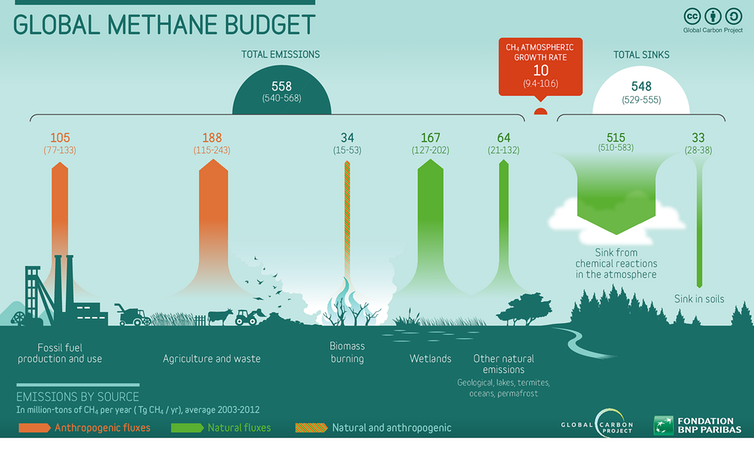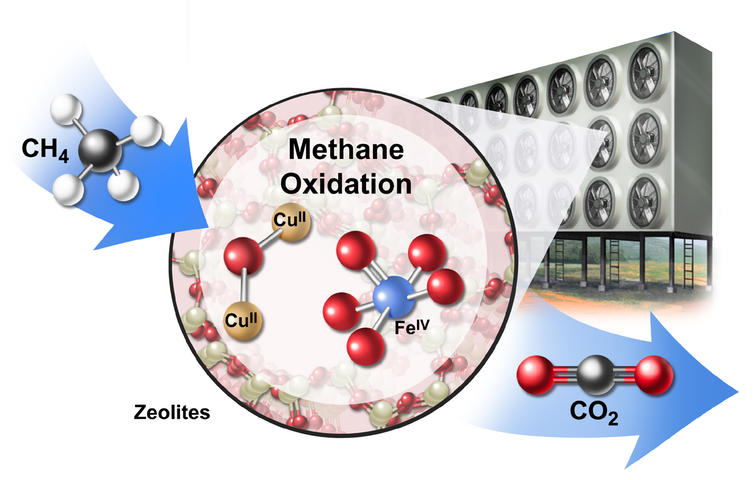
An image of three cows in a field
It’s not cows’ fault they fart, but the methane they produce is warming the planet.
Discussions on how to address climate change have focused, very appropriately, on reducing greenhouse gas emissions, particularly those of carbon dioxide, the major contributor to climate change and a long-lived greenhouse gas. Reducing emissions should remain the paramount climate goal.
However, greenhouse gas emissions have been increasing now for two centuries. Damage to the atmosphere is already profound enough that reducing emissions alone won’t be enough to avoid effects like extreme weather and changing weather patterns.
In a paper published today in Nature Sustainability, we propose a new technique to clean the atmosphere of the second most powerful greenhouse gas people produce: methane. The technique could restore the concentration of methane to levels found before the Industrial Revolution, and in doing so, reduce global warming by one-sixth.
Our new technique sounds paradoxical at first: turning methane into carbon dioxide. It’s a concept at this stage, and won’t be cheap, but it would add to the tool kit needed to tackle climate change.
The methane menace
After carbon dioxide, methane is the second most important greenhouse gas leading to human-induced climate change. Methane packs a climate punch: it is 84 times more powerful than carbon dioxide in warming the planet over the first 20 years of its molecular life.
Methane emissions from human activities are now larger than all natural sources combined. Agriculture and energy production generate most of them, including emissions from cattle, rice paddies and oil and gas wells.
The result is methane concentrations in the atmosphere have increased by 150% from pre-industrial times, and continue to grow. Finding ways to reduce or remove methane will therefore have an outsize and fast-acting effect in the fight against climate change.

CH4 (methane) is a potent greenhouse gas that contributes to human-induced climate change. IMAGE: Global Carbon Atlas
What we propose
The single biggest challenge for removing methane from the atmosphere is its low concentration, only about 2 parts per million. In contrast, carbon dioxide is now at 415 parts per million, roughly 200 times higher. Both gases are much more diluted in air than when found in the exhaust of a car or in a cow’s burp, and both would be better served by keeping them out of the atmosphere to start with.
Nonetheless, emissions continue. What if we could capture the methane after its release and convert it into something less damaging to climate?
That is why our paper proposes removing all methane in the atmosphere produced by human activities – by oxidising it to carbon dioxide. Such an approach has not been proposed before: previously, all removal techniques have only been applied to carbon dioxide.
This is the equivalent of turning 3.2 billion tonnes of methane into 8.2 billion tonnes of carbon dioxide (equivalent to several months of global emissions). The surprising aspect to this trade is that it would reduce global warming by 15%, because methane is so much more warming than carbon dioxide.

Proposed industrial array to oxidise methane to carbon dioxide. IMAGE: Jackson et al. 2019 Nature Sustainability
This reaction yields energy rather than requires it. It does require a catalyst, though, such as a metal, that converts methane from the air and turns it into carbon dioxide.
One fit-for-purpose family of catalysts are zeolites. They are crystalline materials that consist of aluminum, silicon and oxygen, with a very porous molecular structure that can act as a sponge to soak up methane.
They are well known to industrial researchers trying to oxidise methane to methanol, a valuable chemical feedstock.
We envision arrays of electric fans powered by renewable energy to force large volumes of air into chambers, where the catalyst is exposed to air. The catalyst is then heated in oxygen to form and release CO₂. Such arrays of fans could be placed anywhere where renewable energy – and enough space – is available.
We calculate that with removal costs per tonne of CO₂ rising quickly from US$50 to US$500 or more this century, consistent with mitigation scenarios that keep global warming below 2℃, this technique could be economically feasible and even profitable.
We won’t know for sure, though, until future research highlights the precise chemistry and industrial infrastructure needed.
Beyond the clean-up we propose here, methane removal and atmospheric restoration could be an extra tool in humanity’s belt as we aim for stringent climate targets, while providing new economic opportunities.
Future research and development will determine the technical and economic feasibility of methane removal. Even if successful, methane- and other carbon-removal technologies are no substitute for strong and rapid emissions reductions if we are to avoid the worst impacts of global warming.![]()
Pep Canadell, Chief research scientist, CSIRO Oceans and Atmosphere; and Executive Director, Global Carbon Project, CSIRO and Rob Jackson, Chair, Department of Earth System Science, and Chair of the Global Carbon Project, globalcarbonproject.org, Stanford University
This article is republished from The Conversation under a Creative Commons license. Read the original article.


4th March 2020 at 8:59 pm
Sometime ago I read on an australian research at CSIRO that feeding the cows with a particular seaweed (Asparagopsis taxiformis) could reduce methane emissions as much as 99%. This seaweed is invasive in southern Spain which could be a blessing. How is this research progressing? Is it now operational?. Please inform: https://newatlas.com/csiro-seaweed-cow-methane-emissions/46021/?utm_source=Gizmag+Subscribers&utm_campaign=cb8b070074-UA-2235360-4&utm_medium=email&utm_term=0_65b67362bd-cb8b070074-91740857
17th March 2020 at 8:54 am
Hi Antonio, we are on the cusp of commercialising our Future Feed product. More information on this research is available here: https://research.csiro.au/futurefeed/faq/
Thanks,
Georgia
Team CSIRO
11th June 2019 at 9:28 pm
Love your work CSIRO you are one of Australia’s greatest assets.
24th May 2019 at 7:55 pm
Is there any likelihood we could boost methanotrophic bacteria in our soils to also convert methane from cattle?
21st May 2019 at 6:56 pm
Would it make sense to attach these units to feedlots, where methane concentrations are presumably higher than 2 ppm?
22nd May 2019 at 1:54 pm
Hi Ellen,
Our researchers agree that “Yes, this is indeed a great idea and in fact there are some trials in England with tubing near the cow’s mouth sucking up the highly enriched methane air and then converting it into CO2.” Thanks for your interest in this story.
Kind regards,
Kate from the CSIRO communications team
22nd May 2019 at 1:58 pm
Hi Ellen – if you’re interested you can read more here: https://gtr.ukri.org/projects?ref=NE%2FP019641%2F1
21st May 2019 at 4:49 pm
The subeditor over at The Conversation (where you copied the article from) tried a cheap joke, but made the standard mistake in the figure caption – “It’s not cows’ fault they fart, but the methane they produce …”. In fact the dominant source of methane from cattle is from burps (as mentioned in the actual text), due to fermentation in the rumen (the first stomach).